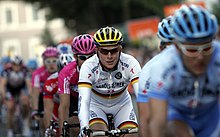Sports photography

In addition to taking pictures of sporting events, sports photography primarily means taking pictures of fast-moving objects, even if that doesn't always have to do with sports. On the other hand, photographing a sporting event can sometimes be classified in other genres (pictures from a chess tournament are more likely to be viewed as portrait photos ).

Sports photos are often close-ups made with powerful telephoto lenses . These have a very shallow depth of field , which makes them look different from what humans see the same scene with their eyes. The total blurring of the background makes the foreground picture-defining, which is why sports photos often look spectacular.
Importance of the dynamics of the sports objects
Fast movements
Telephoto lenses with focal lengths from four to twelve times the normal focal length are often used. Because of the small angle of view, long focal lengths require lenses with high luminous intensity that are large, complex and expensive. The lenses used in sports photography usually cost a multiple of the camera housing .
In addition, image sensors with high light sensitivity are used - at least in field sports and indoor sports . For this purpose, appropriately equipped digital cameras are usually used, which, despite high light sensitivity, show only little image noise and yet can automatically and quickly set the distance .
The camera is often pulled along when taking photos ; For example, one follows the action around the ball in ball sports . This makes this type of photo taking very physically strenuous, which is why some photographers like to work with monopods . The development of powerful, compact digital camera systems with correspondingly light and small telephoto lenses makes this activity much easier.
Sports such as diving or gymnastics are characterized by extremely fast movements and often take place in halls with very poor lighting conditions. The photographer has to plan his pictures beforehand, guess where the action can be seen, and then find the right moment to release it in a fraction of a second. Often, serial pictures are taken here . Modern cameras can take 60 images within two seconds with an image resolution of eight megapixels ( Ultra High Definition Television ). If necessary, images are also saved that were continuously registered in the camera before the shutter button was pressed (English: pre-burst ). Telephoto lenses are also used here, as it is not possible to be in close proximity to the athlete during competitions. Due to the required high ISO settings with very high light sensitivity (up to ISO 6400 and above), these images have a higher image noise than with daylight photos .
Slow movement
In sports that are either less fast than Formula 1 races or less far away than football (e.g. show jumping), you can definitely take attractive pictures with commercially available SLR and viewfinder cameras. The use of the above Sports automatic leads u. U. to quite usable pictures.
Professional photographer genre
Sports photos as we know them from the media are reserved for professional photographers with high-quality equipment and, above all, experience. In addition, photographers at major sports events are only assigned favorable camera positions through accreditation.
technology
Camera settings

Many cameras have a so-called sports program. The camera electronics try to take photos with the highest shutter speed . The aperture is fully opened and the exposure time is determined by the exposure value and the set light sensitivity . With this automatic camera - provided there is sufficient light - relatively sharp images with frozen scenes and minimal depth of field are created .
layout
The photographer's location is often an important factor in sports photography. At major events , professional photographers therefore usually shoot from VIP spots from which they have the best views. It is usually important to get as close as possible to what is happening. Most sports require a good education from the photographer, as the right camera settings have to be found in the shortest possible time in order to prevent spontaneous blurring or incorrect exposure . Sports photography can also be done remotely. These images can also have a good effect on the viewer.
The shutter speed is crucial for the photo taken . A common goal is to get images with minimal blurring, which is why it is advisable to use a slow shutter speed. A special technique is panning , which gives the photos a relatively high degree of sharpness. The background is blurred in the direction of movement, which gives a feeling of speed.
The cameras are often set manually. With large image sensors in full or medium format and bright telephoto lenses, the aperture is slightly closed in order to achieve a sufficiently large depth of field .
The use of light sensitivities up to ISO 3200 and higher is common. In most sports, a fast lens and fast autofocus are crucial for sharp photos . In ball sports , the focal length should also be long enough, as the photographer is usually not close to the action.
See also
literature
- Altschuh, Benedikt (2009): Digital Photo School, Sports and Action Photography. Franzis, Poing, ISBN 978-3-7723-7366-4 .
Web links
- Sportknipser.de - A little introduction to sports photography
- Image recording - moving motifs , Wikibook Digital imaging processes
Individual evidence
- ↑ Digital camera Sony Alpha 7S: Better pictures with fewer pixels , test.de , October 2, 2014, accessed on August 4, 2016
- ↑ Telezoom from Panasonic: Lens for frequent flyers and bird lovers , test.de , June 22, 2016, accessed on August 4, 2016
- ↑ The first extreme telephoto prime - The Olympus 300mm f / 4 IS Pro review , mirrorlessons.com, January 6, 2016, accessed August 4, 2016
- ↑ a b Eugene Fratkin: Panasonic GX8 review , exposedmoment.com, December 21, 2015. Retrieved on August 4, 2016
- ↑ Demanding technology in sports photography , test.de , December 28, 2010, accessed on August 4, 2016

